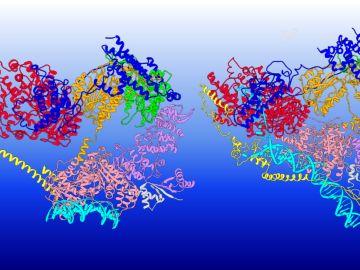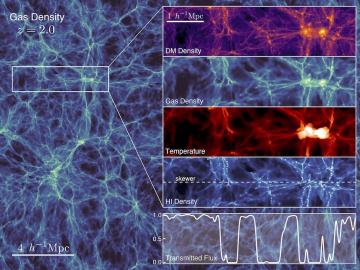
Filter News
Area of Research
- (-) Materials (76)
- (-) Supercomputing (73)
- Advanced Manufacturing (1)
- Biological Systems (1)
- Biology and Environment (56)
- Building Technologies (1)
- Clean Energy (63)
- Computational Engineering (1)
- Computer Science (2)
- Electricity and Smart Grid (1)
- Energy Sciences (1)
- Fuel Cycle Science and Technology (1)
- Fusion and Fission (19)
- Fusion Energy (3)
- Isotope Development and Production (1)
- Isotopes (15)
- Materials Characterization (2)
- Materials Under Extremes (1)
- National Security (26)
- Neutron Science (32)
- Nuclear Science and Technology (2)
News Topics
- 3-D Printing/Advanced Manufacturing (4)
- Advanced Reactors (1)
- Artificial Intelligence (14)
- Big Data (3)
- Bioenergy (3)
- Biology (4)
- Biomedical (3)
- Biotechnology (2)
- Buildings (3)
- Chemical Sciences (16)
- Climate Change (12)
- Composites (2)
- Computer Science (11)
- Coronavirus (2)
- Critical Materials (4)
- Cybersecurity (1)
- Decarbonization (6)
- Energy Storage (5)
- Environment (8)
- Exascale Computing (12)
- Frontier (15)
- Fusion (2)
- Grid (2)
- High-Performance Computing (18)
- Irradiation (1)
- Isotopes (3)
- Machine Learning (4)
- Materials (42)
- Materials Science (7)
- Microscopy (4)
- Molten Salt (1)
- Nanotechnology (4)
- National Security (3)
- Net Zero (2)
- Neutron Science (8)
- Nuclear Energy (5)
- Partnerships (6)
- Physics (10)
- Polymers (4)
- Quantum Computing (8)
- Quantum Science (5)
- Renewable Energy (1)
- Security (1)
- Simulation (9)
- Software (1)
- Summit (6)
- Sustainable Energy (2)
- Transportation (3)
Media Contacts

Transcription factor IIH is a veritable workhorse among the protein complexes that regulate human cell activity, playing critical roles both in synthesizing DNA and in enabling DNA repair. But how can one protein assembly participate in two such vastly different jobs? A team of researchers led by chemistry professor Ivaylo Ivanov of Georgia State University used the Summit supercomputer at ORNL to tackle that question.

A research team from the University of California, Santa Cruz, have used the Oak Ridge Leadership Computing Facility’s Summit supercomputer to run one of the most complete cosmological models yet to probe the properties of dark matter.

With the world’s first exascale supercomputer now fully open for scientific business, researchers can thank the early users who helped get the machine up to speed.

Researchers at the Department of Energy’s Oak Ridge National Laboratory were the first to use neutron reflectometry to peer inside a working solid-state battery and monitor its electrochemistry.

Creating energy the way the sun and stars do — through nuclear fusion — is one of the grand challenges facing science and technology. What’s easy for the sun and its billions of relatives turns out to be particularly difficult on Earth.

As a result of largescale 3D supernova simulations conducted on the Oak Ridge Leadership Computing Facility’s Summit supercomputer by researchers from the University of Tennessee and Oak Ridge National Laboratory, astrophysicists now have the most complete picture yet of what gravitational waves from exploding stars look like.

Scientist-inventors from ORNL will present seven new technologies during the Technology Innovation Showcase on Friday, July 14, from 8 a.m.–4 p.m. at the Joint Institute for Computational Sciences on ORNL’s campus.

An advance in a topological insulator material — whose interior behaves like an electrical insulator but whose surface behaves like a conductor — could revolutionize the fields of next-generation electronics and quantum computing, according to scientists at ORNL.

To support the development of a revolutionary new open fan engine architecture for the future of flight, GE Aerospace has run simulations using the world’s fastest supercomputer capable of crunching data in excess of exascale speed, or more than a quintillion calculations per second.

In late May, the Quantum Science Center convened its first in-person all-hands meeting since the center was established in 2020. More than 120 QSC members gathered in Nashville, Tennessee to discuss the center’s operations, research and overarching scientific aims.


